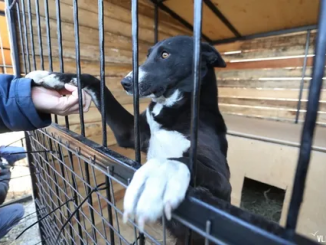Dogs’ brains are sensitive to the familiar high-pitched “cute” voice tone that adult humans, especially women, use to talk to babies, according to a new study.
The research, published recently in the journal Communications Biology, found “exciting similarities” between infant and dog brains during the processing of speech with such a high-pitched tone feature.
Humans tend to speak with a specific speech style characterised by exaggerated prosody, or patterns of stress and intonation in a language, when communicating with individuals having limited language competence.
Such speech has previously been found to be very important for the healthy cognitive, social and language development of children, who are also tuned to such a high-pitched voice.
But researchers, including those from the Eötvös Loránd University in Hungary, hoped to assess whether dog brains are also sensitive to this way of communication.
In the study, conscious family dogs were made to listen to dog, infant and adult-directed speech recorded from 12 women and men in real-life interactions.
As the dogs listened, their brain activities were measured using a functional magnetic resonance imaging (fMRI) scan.
The study found the sound-processing regions of the dogs’ brains responded more to dog- and infant-directed than adult-directed speech.
This marked the first neurological evidence that dog brains are tuned to speech directed specifically at them.
“Studying how dog brains process dog-directed speech is exciting, because it can help us understand how exaggerated prosody contributes to efficient speech processing in a nonhuman species skilled at relying on different speech cues,” explained Anna Gergely, co-first author of the study.
Scientists also found dog- and infant-directed speech sensitivity of dog brains was more pronounced when the speakers were women, and was affected by voice pitch and its variation.
These findings suggest the way we speak to dogs matters, and that their brain is specifically sensitive to the higher-pitched voice tone typical to the female voice.
“Remarkably, the voice tone patterns characterizing women’s dog-directed speech are not typically used in dog-dog communication – our results may thus serve evidence for a neural preference that dogs developed during their domestication,” said Anna Gábor, co-first author of the study.
“Dog brains’ increased sensitivity to dog-directed speech spoken by women specifically may be due to the fact that women more often speak to dogs with exaggerated prosody than men,” Dr Gabor said.

Supermarket in Finland welcomes dogs, with special carts for canine customers

The grocery store in the Finnish city of Tampere even has an official golden retriever who tests out dog treats and shares the results in Instagram videos.
A ‘su-paw-market’ in Finland is welcoming canine customers, with specially-adapted carts which allow dog owners to bring their pooches grocery shopping.
The Kesko grocery chain in the city of Tampere has introduced the “Koirakärry” – dog cart – as a way to welcome in more dog-owning customers at one of its stores, where usually only service animals would be permitted inside the aisles.
“The idea is already used in some countries, but not in Finland, and we have a lot of dog owners nearby,” explains Matilda Tistelgren, who has been operating the supermarket with her partner Joona Pesonen since the spring.
“We have a golden retriever ourselves, and if we go out jogging with the dog and forget something from the store, we don’t want to go home, leave the dog, then have to return to the store ourselves, we want to be able to take the dog with us,” Matilda tells Euronews.

The carts have a dog bed in the bottom, and a clip for leads or harnesses, with owners encouraged to pick up their pups and put them inside – although a future version of the cart might include a small ramp so the dogs can walk in unaided.
Since taking over the management of the supermarket in Tampere’s neighbourhood Kissanmaa – which funnily enough translates as “Cat’s Land” – Matilda and Joona have introduced other pet-friendly innovations.
The couple’s own retriever Tove appears on Instagram with ‘Tove Tastes’ videos where she samples different dog treats.
“Our customers love it,” exclaims Matilda. “In this part of town we have a lot of dog owners and that means a lot of dog customers too, and we already have a lot of hairy regulars,” she adds.



Leave a Reply